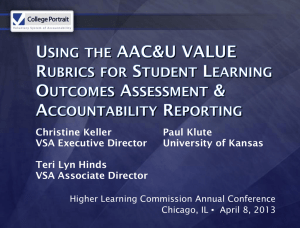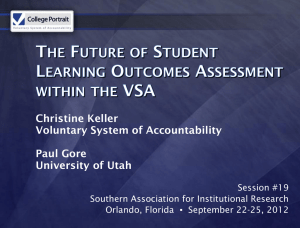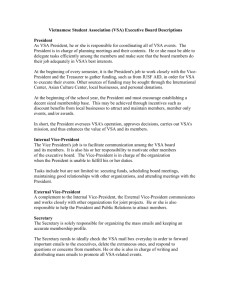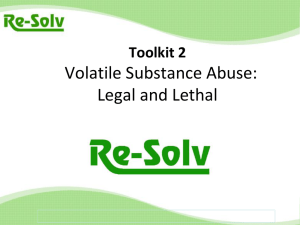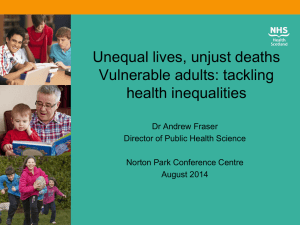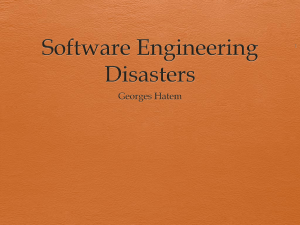PowerPoint - Re-Solv
advertisement
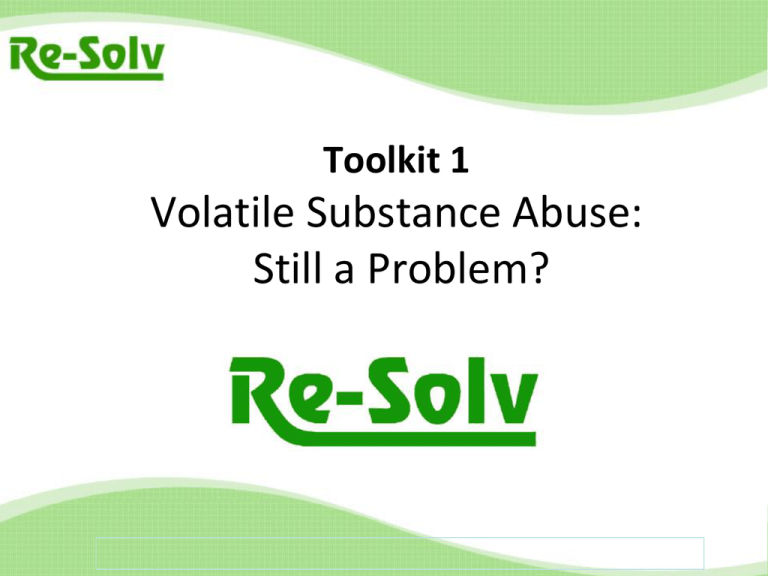
Toolkit 1 Volatile Substance Abuse: Still a Problem? Aims Toolkit completion aims • • • • • • Understand what Volatile Substance Abuse (VSA) is Understand the broad dangers associated with VSA Know VSA mortality rates and trends Know prevalence rates as far as is possible Know what products are used in VSA Understand supply side legislation What is VSA? VSA has not gone away The products abused* change over time The glue sniffing of the past has become the butane gas and aerosol buzzing* of recent years *see slide notes What is VSA? VSA definition The deliberate inhalation of volatile chemicals, gases and solvents found in consumer and industrial products through the mouth and/or nose, for the sole purpose of achieving a ‘high’. What is VSA? What are volatile substances? • Common terms for VSA include ‘buzzing,’ ‘huffing,’ ‘sniffing,’ ‘bagging’. • Volatile Substances* comprise a large group of gases and compounds. • Butane in cigarette lighter refills is the most commonly used volatile substance in recent years. It is colourless and odourless. • Butane and propane are used as the propellant in aerosols. *see slide notes What is VSA? The effects of volatile substances • Inhalation produces rapid, short acting intoxication. • Recovery from the psychoactive* phase is rapid - within 15 - 30 minutes; from the intense phase just a few minutes. *see slide notes What is VSA? Appeal of volatile substances • • • • • • • Accessible* Inexpensive Legal, innocuous* The effect: extreme, hallucinations often reported Readily available despite legislation Easy to conceal Control: rapid intoxication and rapid resolution of intoxication: can use and return to a ‘sober’ state quickly *see slide notes What is VSA? Some reasons why people use* • “I buy mine from supermarkets online. I felt too conspicuous in shops, but no one ever questioned why I was buying 15 deodorants at a time” • “There’s no dunt like a gas dunt.” • “I bet I could find something in this room.” • “Buzzin’ takes me to another place….away from all the crap in my life.” • “It’s been my road to hell.” • “My brothers were doing it so I tried it.” • “My ma drinks..….this is my drink.” • “Yeah, I know I can die doing it. So what? I don’t care.” • “I saw my cousin sniffing hairspray. I only did it once. Am I addicted now?” *see slide notes VSA Dangers “VSA is too dangerous – don't do it” ACMD (Advisory Council for the Misuse of Drugs)* *see slide notes VSA Dangers Why is VSA of concern? • • • • • • • • • • VSA can and does kill - even on the first use. Sudden Sniffing Death is unique to VSA (see next slide). Almost 2,400 recorded deaths in the UK. Absolute Harm Reduction is not an option – there are no ‘safe’ methods of use. Very hidden activity. Associated with young people – youngest deaths aged 7 (1997, 2003). But not exclusively – oldest death 85 (2008). Legislative control of the products used in VSA is extremely difficult, if not impossible.* VSA is not illegal.* Can cause an aggressive effect. *see slide notes VSA Dangers Sudden Sniffing Death* Gases, aerosols, and solvents can make the heart oversensitive to the effect of adrenaline. A burst of activity leads to more adrenaline, leading to an even greater risk of death. This oversensitivity can remain for several hours following recovery from the psychoactive phase. A heart that stops beating as a result of VSA can be very difficult to resuscitate. Defibrillation needs to be administered within 10 minutes. *see slide notes VSA Mortality Mortality Medical research teams at St George’s, University of London, have provided the Trends in UK Deaths Associated with Abuse of Volatile Substances Report since 1971. Mortality details on the following 3 slides all taken from the most recent report.* *see slide notes VSA Mortality Mortality 11% Since 1971, VSA has claimed over 2,390 lives in the UK, with 327 deaths in Scotland. Deaths by primary substance abused in 2009 in the UK 11% Up to 2000, almost 2/3 of deaths were of young people under the age of 19 with the most common age of death being 15. 11% The mean age of death in the UK from 20002009 is 30. 67% The youngest deaths reported were of 7-year-olds (2003, 1997). VSA kills more young people aged 15 and under than all illegal substances. gas fuels aerosols nitrous oxide other VSA Mortality Mortality Standardised Mortality Ratios (SMRs)*, 2000-2009. All ages. Government Region North East North West Yorkshire/Humber East Midlands West Midlands East London South East South West England (all) Wales Scotland Northern Ireland SMR 129 73 112 129 111 89 70 83 74 90 91 172 179 2009 deaths 3 5 3 2 2 4 3 3 0 25 1 17 3 172 129 179 112 73 111 89 91 74 *see slide notes 129 70 83 VSA Mortality Males are at higher risk of death Gender distribution of VSA death 2009 2000-2009 Male 35 (73.9%) 420 (78.5%) Female 12 (26.1%) 115 (21.5%) However, the proportion of adult females (18-years or older) dying from VSA has increased over time, from 1% between 1983-87 (6 deaths) to 17% between 2003-07 (45 deaths). VSA Prevalence VSA prevalence: difficult to determine • Experimental users rarely engage with substance misuse services • Chronic users often report that self stigma prevents them from disclosure and/or service engagement The British Crime Survey* measured substance use amongst 16-59 year olds in England & Wales. Figures from the survey for 2010/11: Ever Used Cocaine 9.6% VSA 2.3% Heroin 0.8% *see slide notes VSA Prevalence Reported Use of Individual Substances, Ever: 13 and 15 years old Solvents, glues and gases 2008 2010 13 year-olds 2% 2% 15 year-olds 4% 3% Poppers* 2008 2010 13 year-olds 1% 1% 15 year-olds 5% 3% Extract: from Table 4.6 SALSUS (Scottish Adolescent Lifestyle And Substance Abuse Survey) 2010* *see slide notes VSA Prevalence Individual Substances Offered, Ever: 13 and 15 years old Solvents, glues and gases 2008 2010 13 year-olds 5% 5% 15 year-olds 9% 7% Poppers 2008 2010 13 year-olds 2% 1% 15 year-olds 12% 6% Extract: from Table 4.16 SALSUS (Scottish Adolescent Lifestyle And Substance Abuse Survey) 2010* *see slide notes VSA Prevalence ESPAD 2011 Lifetime VSA of 15-16 year old students in 36 European Countries. The average across these Countries is 9%. Highest Prevalence Lowest Prevalence Croatia Latvia Slovenia Monaco Greece Malta Sweden United Kingdom Ireland Cyprus Lithuania Ukraine Italy Moldova 28% 23% 20% 15% 14% 14% 11% 10% 9% 8% 7% 3% 3% 2% 2011 ESPAD: The European School Survey Project on Alcohol and Other Drugs* *see slide notes VSA Prevalence Who tries VSA? • VSA cuts across all demographics – there is no stereotypical VS user. • Higher risk is associated with history of trauma - just as with any type of substance misuse. • • • • High rates of 12-16 year-olds reporting ever having used VSs were identified in the following* Those excluded from school (48%), Those who truant from school (41%) Those with impoverished living conditions/street homeless (43%) Those with a record of delinquency/criminal behaviour (26% serious offenders, non offenders 2%) *see slide notes VSA Products What products are used? Hundreds of products found in supermarkets, newsagents, chemists, the home, DIY outlets, schools, offices, industrial sites…etc. Suggested classroom activities* ACTIVITY SLIDE *see slide notes VSA Products Products abused today* Volatile solvents: • Petrol • Industrial glues • Nail polish remover • Paint stripper • Some correctional fluid Gases • Fuel gas • Butane lighter gas • Nitrous oxide (whipped cream canisters)(whippets) Aerosols: • Hair spray • Deodorants • Spray paint • Pain relief spray • Air freshener Nitrites: known as poppers • Video head cleaners • Room odourisers *see slide notes VSA Products Helium • Helium is an inert gas (not a volatile substance) and causes death by asphyxiation, displacing bloodstream oxygen. Using a mask or bag, unconsciousness occurs within seconds, potentially permanent brain damage in 2 minutes, then death. • The St George’s VSA Report has included an early warning on deaths associated with Helium since 2001. • There were 111 Helium deaths* in the period 2001–2009. 26 deaths in 2008, 46 deaths in 2009, 33 deaths in 2010. • 93% of deaths were suicides caused by asphyxia, 6% recorded as open verdict and 1% as misadventure. *see slide notes VSA Products The SACKI Logo* Introduced in 1997, the use of the SACKI logo is voluntary. It does not appear on every product that may be abused. This may lead young experimental users to identify a product without the logo as ‘safer’ than products bearing the logo. *see slide notes VSA & The Law VSA supply - legal matters UK 1. The Cigarette Lighter Refill (Safety) Regulations 1999 Butane gas cigarette lighter refills may not be supplied or sold to under 18-year-olds. This regulation, part of the Consumer Protection Act, was added due to the large number of deaths associated with gas lighter refills. 2. Intoxicating Substances (Supply) Act 1985 (does not include Scotland: see next slide) This act prohibits the sale or supply to persons under the age of 18 of substances which may cause intoxication if inhaled, if the supplier knows or has reasonable cause to believe that the substance is likely to be inhaled for the purposes of intoxication. The penalties for breaking either law is a maximum fine of £5,000 or up to six months imprisonment, or both. VSA & The Law Legal matters – Scotland not just age restriction* Scottish Common Law Selling/supplying any product to anyone of any age knowing that the product will be abused for VSA has been held to constitute criminal conduct. Fines of up to £12,000 and prison sentences of 2 years have been imposed. VSA is sufficient singular cause for referral of a young person to the Children's Panel due to the danger presented during each and every episode of VSA. *see slide notes Contact details Scotland: Marina Clayton Development Manager Scotland 07505 000024 scotland@re-solv.org Re-Solv UK Head Office 01785 817885 information@re-solv.org Questions? Published August 2013. Review date August 2014.
